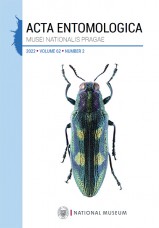Phylogeny, diversity and biogeography of flightless amphi-Pacific lymantine weevils (Coleoptera: Curculionidae: Molytinae)
Grebennikov Vasily V., Anderson Robert S.
Acta Entomologica Musei Nationalis Pragae 62(2): 411-442, 2022
Published online: 31st December 2022
Views: 1597
Abstract: We use DNA sequence data to generate the first phylogenetic hypothesis for the
weevil tribe Lymantini. These are leaf litter inhabiting beetles generally
regarded as restricted to the New World and taxonomically arranged in two
subtribes, 11 genera and some 150 named species. An additional genus of
questionable affinities to the tribe, Devernodes Grebennikov, 2018, has five
described species in Southeastern Asia. All these beetles are flightless and
some have eyes reduced in size or absent, traits normally associated with
limited dispersal capacity. We performed a phylogenetic analysis of
153 terminals (50 of them belong to Lymantini representing Devernodes and all
but three named genera) based on 4,174 bp alignment of one mitochondrial (cox1)
and two nuclear fragments (ITS2 and 28S). We find that both Lymantini subtribes
Lymantina and Caecossonina are monophyletic, the latter sister to the
amphi-Atlantic tribe Anchonini. The Asian genus Devernodes is deeply nested
among American Lymantina. The clade of Anchonini plus Lymantini is consistently
recovered outside of the CCCMS clade of “higher” weevils (Curculioninae,
Conoderinae, Cossoninae, Molytinae and Scolytinae). We hypothesize that the
polished head capsule of adult beetles is an apomorphy of Anchonini and
Lymantini, the 8-segmented antennal funicle is an apomorphy of Anchonini plus
Caecossonina. We attribute the origin of the currently observed amphi-Pacific
distribution of Lymantina to normal ecological dispersal facilitated by the
warmer periods of the Cenozoic such as the Eocene, and by presently submerged
Arctic land bridges. Using parsimony we hypothesize a North American origin for
the Anchonini plus Lymantini crown group, as well as that of Lymantina. We argue
that Bronchotibia adunatus Poinar & Legalov, 2021, a Dominican amber adult
weevil fossil, is not a member of Lymantini and re-classify it as Curculionidae
incertae sedis. We present an image gallery of 28 Lymantini specimens to
document the morphological diversity of the tribe. We hypothesize the existence
of unnamed American genera of Lymantina and make public the DNA-barcode dataset
of 89 Lymantini specimens.
Key words: Coleoptera, Anchonini, Caecossonina, Lymantina, DNA barcode, ITS2, 28S, phylogeny, forest litter, biogeography
Papers
This issue is dedicated to the memory of Svatopluk Bílý (1945–2022)The true identity of Periscelis winnertzii and description of P. laszloi sp. nov. from Europe (Diptera: Periscelididae)Taxonomic revision of Montina (Hemiptera: Heteroptera: Reduviidae) from Colombia with description of three new speciesPlatyplastinx ibanezbernali sp. nov., a new species of moth fly (Diptera: Psychodidae) from EcuadorERRATUM: Platyplastinx ibanezbernali sp. nov., a new species of moth fl y (Diptera: Psychodidae) from Ecuador. Acta Entomologica Musei Nationalis Pragae 62 (2): 383–389. https://doi. org/10.37520/aemnp.2022.020New data on the early stages and behaviour of the endangered species Callophrys mystaphia (Lepidoptera: Lycaenidae) and its first larval parasitoid, Cotesia sp. (Hymenoptera: Braconidae)Megacraspedus (Lepidoptera: Gelechiidae) of the Altai Mountains with description of a new species belonging to the M. majorella groupPhylogeny, diversity and biogeography of flightless amphi-Pacific lymantine weevils (Coleoptera: Curculionidae: Molytinae)The Oleaceae-feeding lace bugs of the genus Perissonemia from Japan (Hemiptera: Heteroptera: Tingidae)Description of a new species of the genus Chrysolina (Coleoptera: Chrysomelidae) from Honshu, and notes on records of Chrysolina aeruginosa in JapanHeteroptera (Hemiptera) of the Socotra Archipelago I: Introduction, Nepomorpha, Gerromorpha and LeptopodomorphaCatalogue of type specimens of braconid wasps (Hymenoptera: Braconidae) deposited in the National Museum, Prague, Czech Republic 